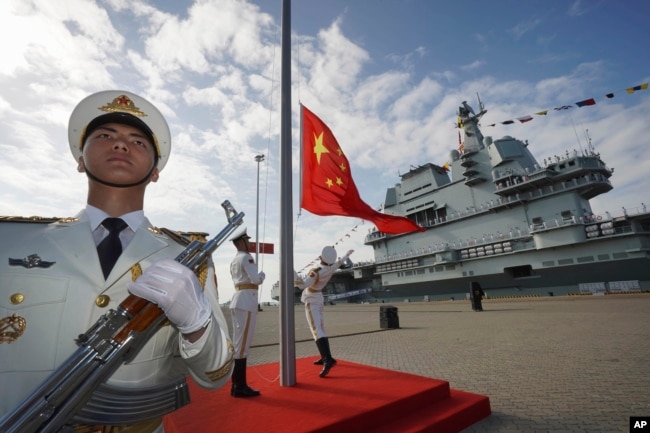AUDIO
China Builds Test Version of Nuclear Reactor for Navy

China has built a land-based test version of a nuclear reactor for a large warship. The development is the clearest sign yet that Beijing is moving toward producing the country’s first nuclear-powered aircraft carrier. This information comes from a new study of satellite imagery and Chinese government documents provided to the Associated Press.
Why is this development important?
There has long been talk that China is planning to build a nuclear-powered aircraft carrier. But the recent research by the Middlebury Institute of International Studies in California is the first to confirm the country is working on a nuclear-powered movement system for a carrier-sized surface warship.
China’s navy is already the world’s largest in terms of numbers.
China's navy has also been developing quickly. Adding nuclear-powered carriers to its fleet would be a major step in realizing its hopes for a force capable of operating around the globe.
Nuclear carriers take longer to build than conventional carriers.

But once nuclear carriers are in operation, they are able to stay at sea for much longer because they do not need to refuel. In addition, there is more room on board for fuel and weapons for aircraft. Nuclear carriers are also able to produce more power to run advanced systems.
Right now, only the United States and France have nuclear-powered carriers. The U.S. has 11 in total, which permits it to keep multiple strike groups deployed around the world at all times, including in the Indo-Pacific area.
But the Pentagon is increasingly concerned about China’s modernization of its fleet, including the design and building of new carriers.
China currently has three carriers, including the new Type 003 Fujian, which was the first both designed and built by China. Officials have said work is already underway on a fourth ship.
But the government has not announced whether that ship will be nuclear or conventionally powered.
How did the researchers arrive at their conclusion?
Middlebury researchers were at first investigating a mountain site outside the city of Leshan in the southwest Chinese province of Sichuan. They had suspicions that China was building a reactor to produce radioactive materials such as plutonium or tritium for weapons. Instead, the researchers said they determined that China was building a test version of a reactor for a large warship.

A number of sources, including satellite images, project tenders, employee files, and environmental impact studies, led researchers to their conclusion.
The reactor is housed in a new structure built at the site known as Base 909, which is under the control of the Nuclear Power Institute of China.
Documents show that China’s 701 Institute, which is responsible for aircraft carrier development, got reactor equipment meant “for installation on a large surface warship.”
The project’s “national defense designation” also helped lead to the conclusion the sizeable reactor is a test version for a next-generation aircraft carrier.
What does China say?
Chinese President Xi Jinping has tasked defense officials with building a “first-class” navy and becoming a naval power as part of his plan for the country.
China’s most recent white paper on national defense, dated 2019, said the Chinese navy was changing due to strategic requirements. The goal was to speed up “the transition of its tasks from defense on the near seas to protection missions on the far seas.”
________________________________________________
Words in This Story
conventional – adj. of traditional design
advanced – adj. greatly developed beyond an early stage
tender – n. an invitation to present an offer or bid (for a project)
install – v. to set up for use or service
transition – n. a change or shift from one state or place to another
https://learningenglish.voanews.com/a/china-builds-test-version-of-nuclear-reactor-for-navy/7863772.html